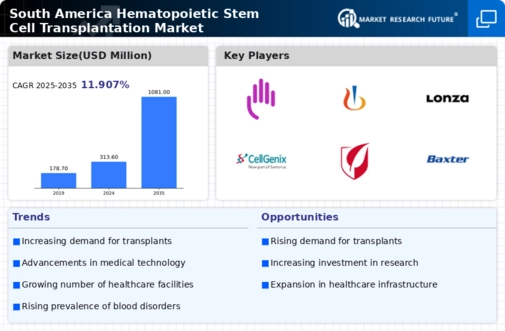Government Initiatives and Funding
Government initiatives aimed at improving healthcare infrastructure are playing a pivotal role in the hematopoietic stem-cell-transplantation market. In South America, various governments are allocating funds to enhance medical facilities and support research in regenerative medicine. For example, recent budget allocations have increased by approximately 20% for healthcare programs focused on stem cell research and transplantation. This financial support is crucial for developing new treatment protocols and expanding access to transplantation services. Additionally, public health campaigns aimed at educating the population about the benefits of stem cell therapies are likely to increase patient enrollment in transplantation programs. As governments continue to prioritize healthcare improvements, the hematopoietic stem-cell-transplantation market is expected to experience sustained growth, driven by enhanced funding and resources.
Advancements in Transplantation Techniques
Innovations in transplantation techniques are significantly influencing the hematopoietic stem-cell-transplantation market. The development of minimally invasive procedures and improved graft-versus-host disease management strategies has enhanced the success rates of transplants. For instance, the introduction of haploidentical transplants has expanded donor options, making it easier for patients to find suitable matches. This advancement is particularly relevant in South America, where donor registries may be limited. As a result, the market is witnessing a shift towards more efficient and effective transplantation methods, which could potentially increase the number of procedures performed annually. The ongoing research and clinical trials aimed at refining these techniques are likely to further bolster the market, as healthcare providers adopt new practices to improve patient outcomes and reduce complications associated with traditional transplantation methods.
Growing Investment in Biotech and Research
The surge in investment in biotechnology and medical research is a significant driver for the hematopoietic stem-cell-transplantation market. In South America, venture capital funding for biotech firms has increased, with investments reaching approximately $500 million in the last year alone. This influx of capital is facilitating the development of innovative therapies and technologies related to stem cell transplantation. Research institutions are also collaborating with private companies to advance clinical trials and improve treatment protocols. As a result, the market is likely to benefit from the introduction of novel therapies that enhance the efficacy and safety of stem cell transplants. The ongoing focus on research and development in this field suggests a promising future for the hematopoietic stem-cell-transplantation market, as new breakthroughs could lead to improved patient outcomes and expanded treatment options.
Rising Incidence of Hematological Disorders
The increasing prevalence of hematological disorders in South America is a crucial driver for the hematopoietic stem-cell-transplantation market. Conditions such as leukemia, lymphoma, and multiple myeloma are becoming more common, leading to a higher demand for effective treatment options. According to recent health statistics, the incidence of leukemia in South America has risen by approximately 15% over the past decade. This trend necessitates the expansion of healthcare services, including stem cell transplantation, to address the growing patient population. As healthcare providers seek to improve patient outcomes, investments in hematopoietic stem-cell-transplantation facilities and technologies are likely to increase, thereby propelling market growth. Furthermore, the rising awareness of treatment options among patients and healthcare professionals is expected to contribute to the overall demand for stem cell therapies in the region.
Increased Collaboration Among Healthcare Providers
The trend of increased collaboration among healthcare providers is emerging as a vital driver for the hematopoietic stem-cell-transplantation market. In South America, hospitals and research institutions are forming partnerships to share knowledge, resources, and best practices related to stem cell transplantation. This collaborative approach is fostering a more integrated healthcare system, which is essential for improving patient care and outcomes. For instance, joint initiatives between public and private sectors are enhancing access to transplantation services, particularly in underserved areas. Furthermore, these collaborations are likely to lead to standardized protocols and training programs, which could improve the overall quality of care in the region. As healthcare providers work together to address the challenges associated with hematopoietic stem-cell-transplantation, the market is expected to grow, driven by enhanced service delivery and patient management.


















Leave a Comment